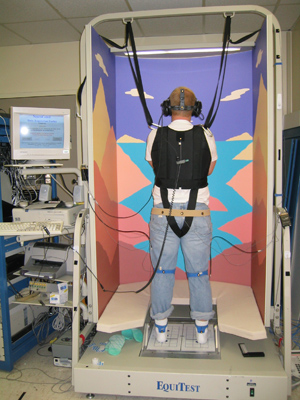Healthcare Engineering
Evaluating Risk of Falls of Postmenopausal Women with Low Bone Mass
Osteoporosis has been known as a silent disease that may cause no symptoms until a fracture occurs. Falling is a determinant of bone fracture. In fact, more than 90% of hip fractures among adults aged 65 and older are caused by falls. Risks of osteoporotic bone fracture can therefore be reduced if risk factors for falls are reduced. If an osteoporotic patient does not fall, fracture may not occur despite a low bone mass density. Particularly in the very elderly, reducing risk factors for falls may be more important than improving the bone strength or bone mass density, because falling presents a much more pressing threat compared with the slow response to bone strength therapy.
Computerized Dynamic Posturography
Postmenopausal women with low bone mass (osteopenia, T-score of bone mineral density between -1 and -2.5) were assessed for dynamic and static standing balance by Computerized Dynamic Posturography with a NeuroCom SMART EquiTest device (see figure below), which is a sensitive predictor of falling in the elderly. A battery of three standardized protocols (Sensory Organization Test; Motor Control Test; Adaptation Test) were implemented to collectively assess the ability of the subjects to maintain standing balance during a variety of static and dynamic perturbations of the environment. Test measures included the time required for the subjects to regain balance following a perturbation of the foot platform. The Sensory Organization Test measures deficits in a subject's ability to maintain static and dynamic posture and evaluated the role of the visual, vestibular and somatosensory systems in maintaining balance. The Motor Control Test measures the capability of the automatic motor system to respond to sudden translational movements of the foot surface platform forward and backward. The Adaptation Test evaluates the subject's capacity to minimize postural sway after balance perturbation arising from sudden movement of the foot platform surface.
Gait Assessment
In a gait assessment, a subject walks on a treadmill instrumented with two force platforms interfaced to a computerized data acquisition system and recorded spatial and temporal parameters of gait related to fall risk: stride length, stride width, cadence, double support time, and speed.

NeuroCom SMART EquiTest for Computerized Dynamic Posturography
Department of Mechanical Engineering
-
Address
Texas Tech University, Box 41021 | Lubbock, TX 79409 -
Phone
806.742.3563 -
Email
mechanical.engineering@ttu.edu
